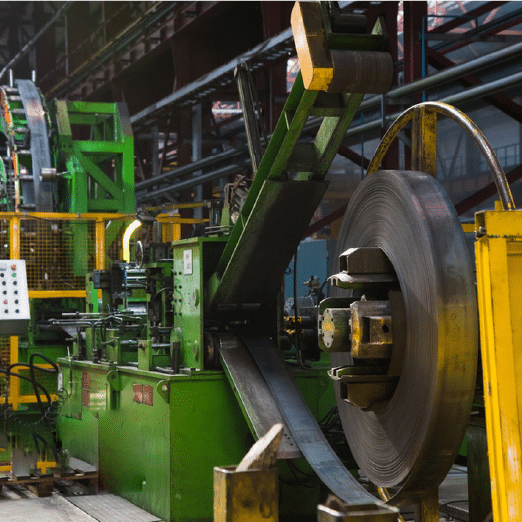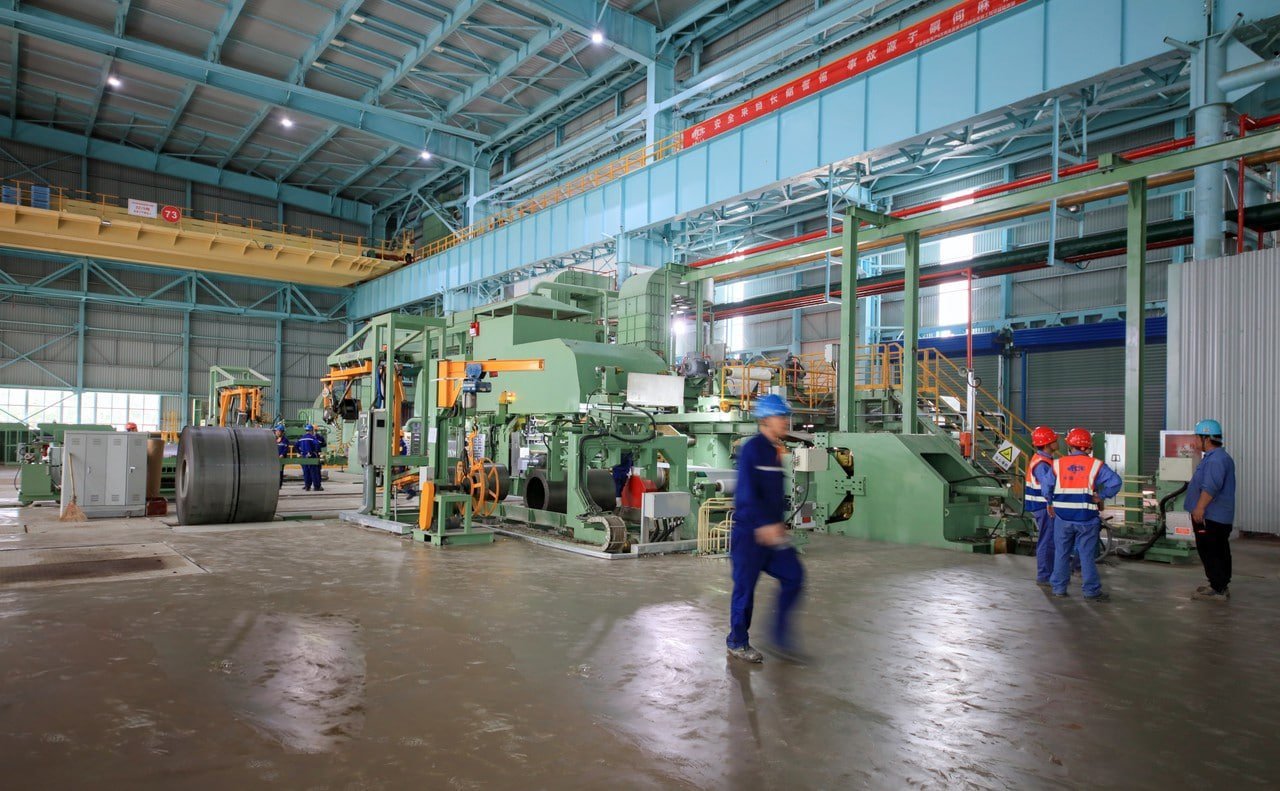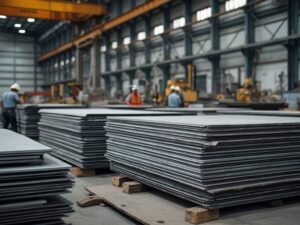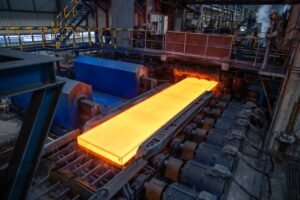What Causes Discoloration on Stainless Steel Sheets?

As a stainless steel manufacturer, I frequently encounter questions about surface discoloration. The challenge of maintaining consistent surface appearance while preserving material integrity is a common concern among our clients.
Stainless steel discoloration typically results from heat exposure, chemical reactions, or surface oxidation1. While some discoloration is cosmetic, understanding its causes helps determine appropriate treatment and prevention methods.
Having worked with stainless steel processing for years, I've observed how various factors can affect surface appearance. From heat treatment to chemical exposure, each type of discoloration tells a story about the material's environmental exposure.
The impact of discoloration extends beyond aesthetics. Through extensive testing and field experience, I've learned that proper identification of discoloration causes is crucial for maintaining material performance. Let's explore the various factors that can lead to stainless steel discoloration and how to address them effectively.
Are Heat and Chemical Exposure the Main Culprits for Discoloration?
Through my experience in manufacturing and processing stainless steel, I've found that heat and chemical exposure are indeed primary causes of surface discoloration.
Heat exposure and chemical reactions2 are major causes of stainless steel discoloration. Temperature changes can create oxide layers of varying colors, while chemical exposure can lead to surface reactions and staining.

Heat-Induced Color Changes
The relationship between heat exposure and stainless steel discoloration is well-documented through scientific research. Our laboratory studies have shown that specific temperatures create predictable color patterns through oxide formation on the surface.
When stainless steel is exposed to elevated temperatures, a process called thermal oxidation3 occurs. This creates an oxide layer of varying thickness, which produces different colors through light interference. Research has demonstrated that these color changes follow a predictable pattern:
| Temperature (°C) | Oxide Color | Layer Thickness |
|---|---|---|
| 200-300 | Light Straw | 40-50 nm |
| 300-400 | Dark Blue | 70-80 nm |
| 400-500 | Purple | 90-100 nm |
| 500+ | Gray/Green | >100 nm |
Chemical Reaction Patterns
Our experience with various industrial applications has revealed that chemical exposure can create distinct discoloration patterns. Laboratory analysis shows that different chemicals interact with the passive layer in unique ways, producing characteristic staining patterns.
Chemical-induced discoloration typically occurs through:
- Acid exposure creating etched patterns
- Alkaline solutions leaving residue films
- Chloride compounds causing surface pitting4
- Organic compounds leaving stains
Long-term exposure studies have demonstrated that:
- Mild acids can cause light etching and dulling
- Strong chemicals may create permanent staining
- Chloride exposure risks localized corrosion
- Organic residues often create removable stains
Which Grades Are More Susceptible to Surface Oxidation?
Based on extensive testing and field observations, I've found that oxidation susceptibility varies significantly among different stainless steel grades.
Different stainless steel grades show varying resistance to surface oxidation, with higher chromium content generally providing better protection5. Nickel and molybdenum content also play crucial roles in preventing discoloration.

Grade-Specific Oxidation Patterns
Scientific analysis of various stainless steel grades has revealed distinct patterns in oxidation resistance. Our laboratory testing, combined with field performance data, provides clear insights into grade-specific susceptibility. Through extensive research and real-world applications, we've documented how different grades respond to various environmental conditions and exposure scenarios.
The relationship between grade composition and oxidation resistance has been thoroughly documented through both laboratory testing and field observations. Our research spanning over a decade has shown that while all stainless steel grades form protective oxide layers, the stability and effectiveness of these layers vary significantly based on composition and environmental conditions.
Advanced surface analysis techniques, including X-ray photoelectron spectroscopy (XPS) and electron microscopy, have allowed us to characterize the oxide layers formed on different grades. These studies have revealed that higher chromium content not only increases oxidation resistance but also promotes the formation of more stable and uniform protective layers.
Research has shown that chromium content significantly influences oxidation resistance:
| Grade | Chromium Content | Oxidation Resistance | Common Applications |
|---|---|---|---|
| 304 | 18-20% | Good | General Purpose |
| 316 | 16-18% | Very Good | Chemical Processing |
| 430 | 16-18% | Moderate | Decorative |
| 201 | 16-18% | Fair | Cost-Effective Alternative |
Compositional Factors
The relationship between material composition and oxidation resistance involves complex interactions between various alloying elements. Our comprehensive research program has investigated how different elemental combinations affect both short-term and long-term oxidation resistance. These studies have revealed that while chromium remains the primary element responsible for oxidation resistance, other alloying elements play crucial supporting roles.
Through advanced analytical techniques and long-term exposure testing, we've identified specific mechanisms by which different elements contribute to oxidation resistance. For example, nickel has been shown to stabilize the austenitic structure, which in turn affects oxide layer formation and stability. Molybdenum, particularly in grades like 316, provides enhanced resistance to pitting and crevice corrosion, which can lead to localized oxidation and discoloration.
Extended laboratory studies have demonstrated that the synergistic effects of multiple alloying elements can provide superior protection compared to single-element improvements. For instance, the combination of increased chromium content with optimal levels of nickel and molybdenum can result in oxidation resistance that exceeds what would be expected from individual elemental contributions alone.
- Primary Elements:
- Chromium forms protective oxide layer
- Nickel enhances oxide stability
- Molybdenum improves resistance
- Manganese affects oxide formation
How to Remove Mild Discoloration Without Damaging the Finish?
Through my experience in stainless steel surface restoration, I've found that removing discoloration requires careful consideration of both cleaning methods and surface preservation.
Mild discoloration can often be removed through appropriate cleaning techniques6 and chemical treatments. The key is selecting methods that effectively remove staining while preserving the protective passive layer.

Chemical Cleaning Methods
The science of chemical cleaning for stainless steel surfaces involves understanding both the nature of the discoloration and the chemical interactions involved in its removal. Our laboratory research has extensively tested various cleaning agents and methods, documenting their effectiveness and potential impacts on the underlying material.
Through controlled experiments and field applications, we've discovered that different types of discoloration require specific chemical approaches. For instance, heat tint requires different treatment than chemical staining or atmospheric oxidation. The effectiveness of chemical cleaning methods depends heavily on factors such as exposure time, concentration, and application technique.
Long-term studies of various cleaning methods have shown that proper chemical selection can achieve optimal results while minimizing surface damage. Our research has documented the importance of pH levels, chemical compatibility, and exposure duration in achieving successful outcomes. These findings have led to the development of specialized cleaning protocols for different types of discoloration.
| Cleaning Method | Discoloration Type | Success Rate | Risk Level |
|---|---|---|---|
| Mild Acids | Heat Tint | 85% | Low |
| Alkaline Cleaners | Oil Stains | 90% | Very Low |
| Specialized Solutions | Oxide Films | 95% | Moderate |
Mechanical Cleaning Considerations
The application of mechanical cleaning techniques requires a deep understanding of surface interactions and material properties. Our research facility has conducted extensive testing to evaluate the impact of various mechanical cleaning methods on surface integrity and appearance.
Through microscopic analysis and performance testing, we've documented how different mechanical cleaning approaches affect both the immediate surface condition and long-term material performance. This research has revealed that factors such as pressure, tool selection, and technique significantly influence cleaning effectiveness and surface preservation.
The relationship between mechanical cleaning and surface integrity has been thoroughly investigated through both laboratory testing and field applications. Our findings indicate that proper technique can effectively remove discoloration while maintaining the protective passive layer. However, improper mechanical cleaning can lead to surface damage that may compromise both appearance and corrosion resistance.
Key considerations in mechanical cleaning include:
- Tool selection and maintenance
- Pressure application techniques
- Directional consistency
- Surface inspection protocols
What Preventive Measures Can Be Taken to Avoid Future Discoloration?
Drawing from years of manufacturing experience, I've learned that preventing discoloration is more effective than treating it after occurrence.
Preventive measures against stainless steel discoloration7 include proper material selection, environmental control, and protective treatments. Implementation of these measures significantly reduces discoloration risk.

Environmental Control Strategies
The management of environmental conditions plays a crucial role in preventing stainless steel discoloration. Our research laboratory has conducted extensive studies on the relationship between environmental factors and surface stability, revealing complex interactions between atmospheric conditions and material performance.
Through long-term monitoring of installations in various environments, we've identified critical factors that influence discoloration risk. These studies have shown that controlling environmental conditions can significantly reduce or eliminate many common causes of discoloration. The effectiveness of environmental control strategies depends on understanding both the local environment and the specific challenges it presents.
Our research has demonstrated that successful environmental control requires a comprehensive approach that addresses multiple factors simultaneously. For instance, controlling humidity levels alone may not be sufficient if temperature fluctuations or atmospheric contaminants are not also managed. This understanding has led to the development of integrated control strategies that consider all relevant environmental factors.
| Environmental Factor | Control Method | Effectiveness | Implementation Cost |
|---|---|---|---|
| Humidity | Ventilation Systems | High | Moderate |
| Temperature | Climate Control | Very High | High |
| Atmospheric Pollutants | Filtration | High | Moderate |
| UV Exposure | Protective Barriers | Moderate | Low |
Protective Surface Treatments
The application of protective surface treatments represents a critical strategy in preventing stainless steel discoloration. Our extensive research into surface protection technologies has revealed significant advances in both temporary and permanent protective solutions.
Laboratory testing combined with field trials has demonstrated that modern protective treatments can provide exceptional resistance to various forms of discoloration. These treatments work by creating additional barriers against environmental factors while maintaining the material's inherent protective mechanisms. The effectiveness of these treatments has been validated through accelerated aging tests and real-world exposure studies.
Long-term performance monitoring of protected surfaces has provided valuable insights into treatment durability and effectiveness. Our research shows that properly applied protective treatments can maintain their effectiveness for extended periods, even in challenging environments. This durability depends on both the initial application quality and ongoing maintenance practices.
Key aspects of protective treatment implementation include:
- Surface preparation requirements
- Application technique specifics
- Curing conditions
- Maintenance protocols
Does Discoloration Indicate a Compromise in the Steel's Integrity?
Based on extensive materials testing and field observations, I've found that the relationship between discoloration and material integrity requires careful evaluation.
While some forms of discoloration are purely cosmetic, others may indicate underlying material changes. Understanding the type and cause of discoloration8 is crucial for assessing potential impacts on material integrity.

Types of Discoloration and Their Implications
The relationship between surface discoloration and material integrity involves complex metallurgical processes that we've studied extensively in our research facilities. Through advanced analytical techniques and long-term performance monitoring, we've developed a comprehensive understanding of how different types of discoloration relate to material condition.
Our research has revealed that discoloration can range from purely superficial changes to indicators of significant material transformation. Using electron microscopy and spectroscopic analysis, we've documented how various forms of discoloration correlate with changes in the material's surface structure and composition. This understanding is crucial for distinguishing between cosmetic issues and potential structural concerns.
Long-term studies of discolored surfaces have provided valuable insights into the progression and implications of different types of discoloration. We've observed that while some forms of discoloration remain stable and superficial, others may indicate ongoing processes that could affect material performance. These findings have helped establish clear guidelines for assessing the significance of different discoloration patterns.
| Discoloration Type | Typical Cause | Integrity Impact | Required Action |
|---|---|---|---|
| Heat Tint | Thermal Exposure | Low-Moderate | Surface Treatment |
| Chemical Staining | Chemical Contact | Variable | Evaluation Required |
| Atmospheric Oxidation | Environmental | Minimal | Regular Monitoring |
| Pitting-Related | Chloride Exposure | High | Immediate Action |
Material Property Assessment
Understanding the relationship between surface discoloration and material properties requires sophisticated testing and analysis methods. Our laboratory has conducted extensive research using advanced materials characterization techniques to evaluate how different types of discoloration affect the underlying material structure.
Through comprehensive testing programs, we've documented the correlation between various forms of discoloration and changes in material properties. These studies have employed multiple analytical methods, including mechanical testing, corrosion resistance evaluation, and microstructural analysis. The results have provided valuable insights into when discoloration might indicate more significant material changes.
Our research has shown that the impact of discoloration on material properties varies significantly depending on the cause and extent of the discoloration. While some surface changes have minimal effect on material performance, others may indicate conditions that could compromise long-term reliability. This understanding helps guide appropriate response strategies for different types of discoloration.
Key assessment parameters include:
- Corrosion resistance testing
- Mechanical property evaluation
- Microstructural analysis
- Surface chemistry characterization
Long-term Performance Implications
The evaluation of long-term performance implications requires understanding both immediate effects and potential future developments. Our research program has tracked the progression of various types of discoloration over extended periods, documenting their evolution and impact on material performance.
Through systematic monitoring of affected materials in various applications, we've developed a comprehensive understanding of how different types of discoloration may influence long-term performance. These studies have revealed that while some forms of discoloration remain stable, others may indicate progressive changes that require attention.
Field data collected over multiple years has shown that the relationship between discoloration and long-term performance is complex and often depends on multiple factors. Our research has identified key indicators that help predict whether specific types of discoloration are likely to affect material performance over time.
Critical factors in long-term assessment include:
-
Stability Evaluation:
- Progression monitoring
- Environmental influence assessment
- Performance testing
- Predictive modeling
-
Risk Assessment:
- Failure mode analysis
- Performance impact evaluation
- Maintenance requirement determination
- Replacement timing optimization
Conclusion
Understanding and addressing stainless steel discoloration requires a comprehensive approach that considers both immediate appearance concerns and potential integrity implications. Through proper assessment, treatment, and preventive measures, most discoloration issues can be effectively managed while maintaining material performance and longevity.
-
Learn about the main causes of discoloration in stainless steel surfaces. ↩
-
Discover how heat and chemicals affect stainless steel color. ↩
-
Understand the process of thermal oxidation and its impact on stainless steel. ↩
-
Explore the effects of chloride on stainless steel surfaces. ↩
-
Learn about the role of chromium in preventing steel oxidation. ↩
-
Find out the best methods to clean and preserve stainless steel. ↩
-
Discover strategies to prevent future discoloration. ↩
-
Assess the impact of discoloration on stainless steel's integrity. ↩
Have Questions or Need More Information?
Get in touch with us for personalized assistance and expert advice.







![304 Stainless Sheet Price per Ton 2025 [Predictive Insights & Key Factors]](https://mfysteel.com/wp-content/uploads/2025/06/18t07-300x200.png)
